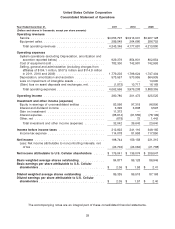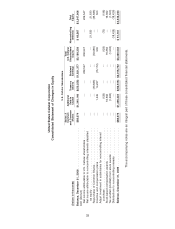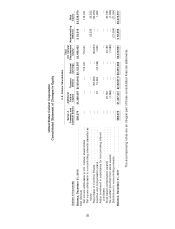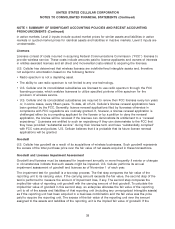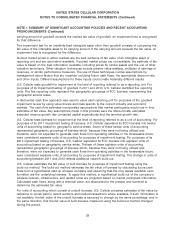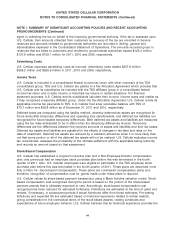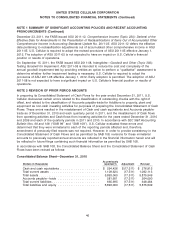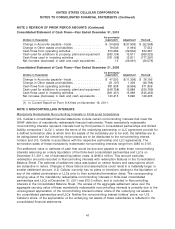US Cellular 2011 Annual Report Download - page 46
Download and view the complete annual report
Please find page 46 of the 2011 US Cellular annual report below. You can navigate through the pages in the report by either clicking on the pages listed below, or by using the keyword search tool below to find specific information within the annual report.UNITED STATES CELLULAR CORPORATION
NOTES TO CONSOLIDATED FINANCIAL STATEMENTS (Continued)
NOTE 1 SUMMARY OF SIGNIFICANT ACCOUNTING POLICIES AND RECENT ACCOUNTING
PRONOUNCEMENTS (Continued)
in active markets. Level 2 inputs include quoted market prices for similar assets and liabilities in active
markets or quoted market prices for identical assets and liabilities in inactive markets. Level 3 inputs are
unobservable.
Licenses
Licenses consist of costs incurred in acquiring Federal Communications Commission (‘‘FCC’’) licenses to
provide wireless service. These costs include amounts paid to license applicants and owners of interests
in entities awarded licenses and all direct and incremental costs related to acquiring the licenses.
U.S. Cellular has determined that wireless licenses are indefinite-lived intangible assets and, therefore,
not subject to amortization based on the following factors:
• Radio spectrum is not a depleting asset.
• The ability to use radio spectrum is not limited to any one technology.
• U.S. Cellular and its consolidated subsidiaries are licensed to use radio spectrum through the FCC
licensing process, which enables licensees to utilize specified portions of the spectrum for the
provision of wireless service.
• U.S. Cellular and its consolidated subsidiaries are required to renew their FCC licenses every ten years
or, in some cases, every fifteen years. To date, all of U.S. Cellular’s license renewal applications have
been granted by the FCC. Generally, license renewal applications filed by licensees otherwise in
compliance with FCC regulations are routinely granted. If, however, a license renewal application is
challenged either by a competing applicant for the license or by a petition to deny the renewal
application, the license will be renewed if the licensee can demonstrate its entitlement to a ‘‘renewal
expectancy.’’ Licensees are entitled to such an expectancy if they can demonstrate to the FCC that
they have provided ‘‘substantial service’’ during their license term and have ‘‘substantially complied’’
with FCC rules and policies. U.S. Cellular believes that it is probable that its future license renewal
applications will be granted.
Goodwill
U.S. Cellular has goodwill as a result of its acquisitions of wireless businesses. Such goodwill represents
the excess of the total purchase price over the fair value of net assets acquired in these transactions.
Goodwill and Licenses Impairment Assessment
Goodwill and licenses must be assessed for impairment annually or more frequently if events or changes
in circumstances indicate that such assets might be impaired. U.S. Cellular performs its annual
impairment assessment of goodwill and licenses as of November 1 of each year.
The impairment test for goodwill is a two-step process. The first step compares the fair value of the
reporting unit to its carrying value. If the carrying amount exceeds the fair value, the second step of the
test is performed to measure the amount of impairment loss, if any. The second step compares the
implied fair value of reporting unit goodwill with the carrying amount of that goodwill. To calculate the
implied fair value of goodwill in this second step, an enterprise allocates the fair value of the reporting
unit to all of the assets and liabilities of that reporting unit (including any unrecognized intangible assets)
as if the reporting unit had been acquired in a business combination and the fair value was the price
paid to acquire the reporting unit. The excess of the fair value of the reporting unit over the amount
assigned to the assets and liabilities of the reporting unit is the implied fair value of goodwill. If the
38



